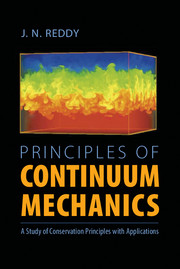Book contents
- Frontmatter
- Contents
- Preface
- 1 Introduction
- 2 Vectors and Tensors
- 3 Kinematics of a Continuum
- 4 Stress Vector and Stress Tensor
- 5 Conservation of Mass, Momentum, and Energy
- 6 Constitutive Equations
- 7 Applications in Heat Transfer, Fluid Mechanics, and Solid Mechanics
- Answers to Selected Problems
- References and Additional Readings
- Subject Index
4 - Stress Vector and Stress Tensor
- Frontmatter
- Contents
- Preface
- 1 Introduction
- 2 Vectors and Tensors
- 3 Kinematics of a Continuum
- 4 Stress Vector and Stress Tensor
- 5 Conservation of Mass, Momentum, and Energy
- 6 Constitutive Equations
- 7 Applications in Heat Transfer, Fluid Mechanics, and Solid Mechanics
- Answers to Selected Problems
- References and Additional Readings
- Subject Index
Summary
A man may imagine things that are false, but he can only understand things that are true, for if the things be false, the apprehension of them is not understanding.
Isaac NewtonIntroduction
In the beginning of Chapter 3, we briefly discussed the need to study deformation in materials that we may design for engineering applications. All materials have a certain threshold to withstand forces, beyond which they “fail” to perform their intended function. The force per unit area, called stress, is a measure of the capacity of the material to carry loads, and all designs are based on the criterion that the materials used have the capacity to carry the working loads of the system. Thus, it is necessary to determine the state of stress in materials that are used in a system.
In the present chapter, we study the concept of stress and its various measures. For instance, stress can be measured as a force (that occurs inside a deformed body) per unit deformed area or undeformed area. Stress at a point on the surface and at a point inside a three-dimensional continuum are measured using different entities. The stress at a point on the surface is measured in terms of force per unit area and depends on (magnitude and direction) the force vector as well as the plane on which the force is acting.
- Type
- Chapter
- Information
- Principles of Continuum MechanicsA Study of Conservation Principles with Applications, pp. 93 - 110Publisher: Cambridge University PressPrint publication year: 2010



